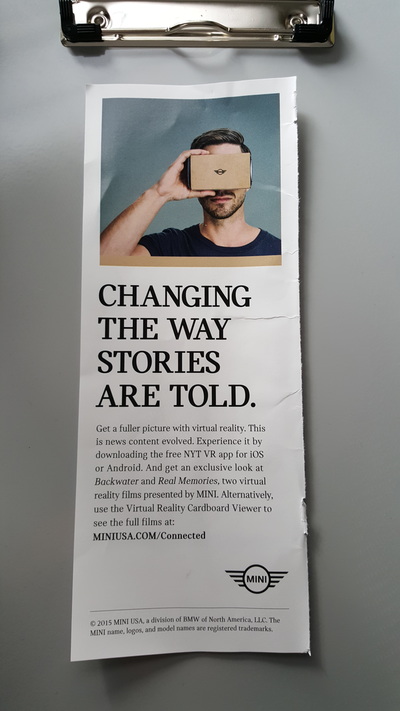Virtual reality: Is it really changing the way stories are told?
by Felicia T Perez (interview with Terry Marshall)
The Center for Story-based Strategy (CSS) is a national movement-building organization dedicated to harnessing the power of narrative for social change. We offer social justice networks, alliances and organizations the analysis, training and strategic support to change the story on the issues that matter most. So naturally, when new technology comes along that can affect how stories are told/shared, we want to check them out and consider their influence and ability to "Change The Story" and bend the arc towards justice.
Almost a year ago CSS began noticing a lot of talk about the future of Virtual Reality having quite a public impact beyond the world of gamers and gaming in general. Panels and workshops at conferences across the country (and beyond), and informal conversations with national journalists were all getting us to think, "What do we (at CSS) know about this Virtual Reality? What can it do to change the story? How is it any different than radio, print media, film, social media and so on?"
We knew we had to look into this soon. And that's when it literally came knocking at the door.
On Sunday, November 1st, the New York Times included an 8-page pullout advertisement announcing that the NYT and Google had combined forces for a new campaign.
oon everywhere one couldn't help but note article after article laying out the details of the campaign. It was also hard not to notice some pretty witty taglines and phrases setting up what the NYT was hoping to change in the way they delivered the news (or, as they are overtly stating, change in their "storytelling").
"The New York Times will distribute Google Cardboard virtual reality (VR) viewers to its home-delivery newspaper customers in the U.S. as part of a new campaign."
- Venture Beat
Some noteworthy favorites include:
"Every day, we bring the world to our readers. Today, we bring our readers the world."
"See For Yourself"
"Look at Things in a New Way."
"Virtual Reality: The Storyteller's Newest Tool."
"Changing The Way Stories Are Told."
So CSS decided to take a look at what all this NYT Virtual Reality (VR) buzz was about.
We asked our Creative Projects Associate, Felicia Perez and one of our Training Associates from Intelligent Mischief, Terry Marshall, to check out the virtual reality videos and let us know what they thought. This is what what they had to say.
SO WHAT DID YOU THINK ABOUT THE VIDEO? WHAT ARE YOUR GENERAL THOUGHTS?
TM: It was cool. I mean I've experienced VR before, but every time it's a new crazy. I thought it was great how they connected three different regions and children's stories together. I move around a lot. I ended up in really different places and I even ran into a wall.
FP: I've never seen anything in VR before. This was amazing! I was sitting down in a swivel chair and I just kept going around in circles. I found myself looking at the floor, the sky or ceiling and the corners of walls. It was like I was trying to catch something wrong or find a missing clue. I feel like I was trying to play a video game or see what was missing the story. It was a little weird in that way because I couldn't pay attention to the subtitles and text in front of me and it didn't stay up for very long. The sound and sight connection made it very immersive.
WHAT STRUCK YOU AS SOMETHING REALLY COOL ABOUT THIS PLATFORM FOR STORYTELLING, FOR SHARING NEWS STORIES FOR NOW AND FOR THE FUTURE?
TM: Immediately after I tested Google Cardboard a few months ago I thought, this could be used for telling stories and get folks to be more empathetic especially if you are not a part of that world. When I was watching the video now my sister kept asking me what I was doing. I told my sister I was in virtual reality and I told her about the countries I was in and that I was being transported there. She was very confused and fascinated at the same time. We're so used to watching film in a picture, but being able to look all around is what makes it immersive.
FP: Yes the coolest part is that it is totally immersive as long as you have headphones on and have the volume up high enough. You are literally taken out of your world and placed somewhere else in a way that goes beyond what your imagination can do when you read a book or your ability to let yourself go in a movie theater. It is a "See For Yourself" moment but it is still only in the confines of what the storyteller or journalist or movie maker wants you to see. It still has the limitations of being in a narrative frame. You don't have the full control of knowing the story for yourself. I mean just because I can look around, doesn't mean I can actually see more.
TM: I think this could really take off or at the very least it will have a niche community who is totally into VR. For some reason too, I think some folks may push back against it too. Maybe for the reasons you just mentioned. I also heard that the new XBox coming out will have VR capacity for its new games.
FP: What kind of effect will that have on 1st person shooter games? What kind of impact can that have on how our youth "play" with violence for an unlimited about of time? Seems like there is a lot of room for questionable things to happen there. Seems like a great way for covert military recruitment in a way that has no time limit like commercials or workshops do.
mean just because I can look around, doesn't mean I can see more.
DID YOU THINK THERE ARE ANY LIMITATIONS TO THIS TYPE OF FORMAT?
WHAT WAS MISSING FOR YOU? WHAT WOULD YOU HAVE LIKED TO SEE?
TM: Well, this wasn’t true VR because you, the viewer, were not able to participate in the video. True virtual reality allows you to interact with the world you are in. Here you can look around, but you can’t participate in the story. With Google Cardboard you have to hold it up to your face. You may get tired of holding it up after awhile. Maybe that is why the videos are so short.
FP: Oh my gosh! You're a genius! This is exactly what I was trying to put my finger on. Because this is not true VR there is no way for you to change the story! This is what CSS is all about and what we talk about. This platform has the potential to allow folks to see the effects of their decisions or indecisions. They see the power that they have to make a difference. But in this style of VR we are still just passive recipients of "the news" and what is dangerous is that it is being sold as VR and you think you can do more in this format but you really can't. Maybe the story keeps your attention for longer than a print version of the story but is attention what we are really going for?
Well, this wasn’t true VR because true virtual reality allows you to interact with the world you are in.
IF YOU COULD MAKE YOUR OWN VR STORY,
USING THIS PLATFORM, WHAT WOULD IT BE ABOUT?
TM: I would make something about the Black Body Survival Guide. Or something animated and video game like as long as it puts you in a different world. I also think this could be really good for "How To" videos and stories that take you behind the scenes of how something is made.
FP: Agree with all of your suggestions. But I can't help but think that this platform has the potential to be really dangerous too. The whole idea of, "See For Yourself," really scares me as a way for people to support misinformation just because they saw it in VR. Just for a minute think of what it would be like if Fox News was who put this campaign together. Or if some day they can make their own news videos in VR. Misinformation could someday be put out there in such a way that folks think not only did I see it on the news, but I, "Saw it for myself." Just because I can look at the floor and the sky in a VR video, doesn't mean I can zoom in or zoom out and see the narrative frame of the story. In the film we saw, The Displaced, I couldn't see outside of the frame or the narrative I was being given. This for me is what the work of CSS is all about. Our ability to analyze the narrative and look beyond what we are being shown. I guess for me virtual reality is just a wolf in sheep's clothing. Really really cool sheep's clothing!
So now we want you to check out the NYTVR and let us know what YOU think!
Get Google Cardboard HERE!
And then download the NYT App watch the video by pressing the button below.









